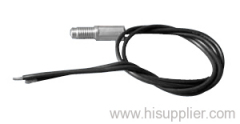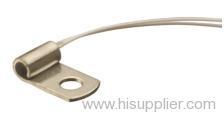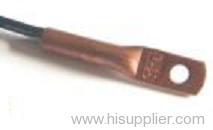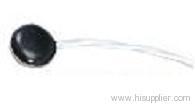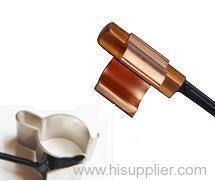
|
AMWEI Thermistor Co., Ltd.
|
NTC Thermistors Temperature Sensors
| Place of Origin: | Guangdong, China (Mainland) |
|
|
|
| Add to My Favorites | |
| HiSupplier Escrow |
Product Detail
NTC Thermistor can be assembled in housing in a variety of configurations for temperature sensing, measurement, detection, indicator, monitor, control
NTC Thermistor can be assembled in housing in a variety of configurations for temperature sensing, measurement, detection, indicator, monitoring and control. Thermistor temperature sensor probe assemblies can conveniently attach to or be an integral part of any system to monitor or control temperature.The choice of assembly is dependent on the application. The primary factors which determine the optimum configuration of a thermistor assembly are the operating environment, mounting, time response and minimum dissipation constant.
The two factors which do vary considerably with thermistor sensor probe assembly design are time constant and dissipation constant. The time constant will typically be of greater duration in encapsulated thermistors. This is, of course, due to additional mass surrounding the thermistor element; therefore, extending the thermal transfer time. Dissipation constant will also be greater in assemblies. The additional housing mass serves well as a heat sink. Greater power is therefore required to induce self-heating. Both time constant and dissipation constant will vary with the selected thermistor and housing. Heat transfer properties of the housing, thermistor location, mass and wire type determine these constants.
Applications for temperature sensing include air temperature sensors, surface temperature sensors and immersion temperature sensors. Housings for air temperature sensors are often simple, inexpensive devices such as molded plastic shells, deep-drawn brass or aluminum cylinders, or even stainless steel tubes. Surface temperature sensors are designed to match the contour of the surface to be sensed, whether it's flat, curved, or round. Mounting holes or clips are often used to simplify installation of the sensor. Immersion temperature sensors are designed so that the sensing element will be surrounded by the medium to be sensed, often times a liquid. The sensing portion will normally protrude through a hole or orifice while a portion of the assembly will remain outside the medium to allow for the signal to be read. Immersion housings are usually threaded to allow them to be screwed into a hole or opening. Immersion part requests to be liquid and humidity prevention.
The material used for the housing will be dependent upon the temperature range needed, response time, cost, and special considerations such as UL, FDA or NSF requirements in food and/or medical applications. Some of the materials available include stainless steel, copper, plastic, teflon, brass, aluminum, epoxy and heat shrinkable tubing.
The two factors which do vary considerably with thermistor sensor probe assembly design are time constant and dissipation constant. The time constant will typically be of greater duration in encapsulated thermistors. This is, of course, due to additional mass surrounding the thermistor element; therefore, extending the thermal transfer time. Dissipation constant will also be greater in assemblies. The additional housing mass serves well as a heat sink. Greater power is therefore required to induce self-heating. Both time constant and dissipation constant will vary with the selected thermistor and housing. Heat transfer properties of the housing, thermistor location, mass and wire type determine these constants.
Applications for temperature sensing include air temperature sensors, surface temperature sensors and immersion temperature sensors. Housings for air temperature sensors are often simple, inexpensive devices such as molded plastic shells, deep-drawn brass or aluminum cylinders, or even stainless steel tubes. Surface temperature sensors are designed to match the contour of the surface to be sensed, whether it's flat, curved, or round. Mounting holes or clips are often used to simplify installation of the sensor. Immersion temperature sensors are designed so that the sensing element will be surrounded by the medium to be sensed, often times a liquid. The sensing portion will normally protrude through a hole or orifice while a portion of the assembly will remain outside the medium to allow for the signal to be read. Immersion housings are usually threaded to allow them to be screwed into a hole or opening. Immersion part requests to be liquid and humidity prevention.
The material used for the housing will be dependent upon the temperature range needed, response time, cost, and special considerations such as UL, FDA or NSF requirements in food and/or medical applications. Some of the materials available include stainless steel, copper, plastic, teflon, brass, aluminum, epoxy and heat shrinkable tubing.
Didn't find what you're looking for?
Post Buying Lead or contact
HiSupplier Customer Service Center
for help!
Related Search
Ntc Thermistor Temperature Sensor
Sensors
NTC Thermistor
Laser Sensors
Water Sensors
Auto Oxygen Sensors
More>>

.jpg)
.jpg)
.jpg)
.jpg)
.jpg)
.jpg)
.jpg)
.jpg)
.jpg)
.jpg)
.jpg)
.jpg)
.jpg)
.jpg)
.jpg)
.jpg)
.jpg)
.jpg)
.jpg)
.jpg)
.jpg)
.jpg)
.jpg)
.jpg)
.jpg)
.gif)
.gif)
.gif)
.jpg)
.jpg)
